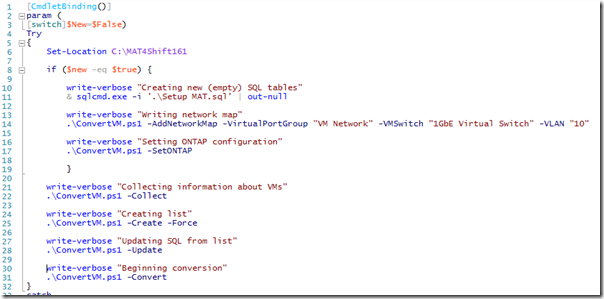Migration - MAT4SHIFT 1.6.1 Release to Web
Today we published the latest version of the Migration Automation Toolkit, MAT4SHIFT v1.6.1. This is largely a maintenance release but does include a few new features.
If you are looking at this technology for the first time, MAT4SHIFT is a script framework/toolkit for automating migrations from VMware to Hyper-V. The unique value is leveraging the NetAPP SHIFT platform so the VMDK to VHD storage conversions are very fast, minimizing downtime and making the concept of “warm conversions” possible (migration during a change window). The scripts are available as a download from the TechNet gallery and are used to manage the migration at scale including rollback, tools removal, and storage/networking consistency.
A HUGE THANK YOU goes out to the MAT community for reporting bugs and showing us all of the interesting ways that MAT is being extended, and to Glen Sizemore (NetAPP) who took the reigns on this release and almost single handedly delivered the changes.
Maintenance
- All known bugs to this point in time
- Localization improvements
- Overall script refactoring to make best practice improvements
New Features
- Conversion Script Parameters – the ConvertVM.ps1 file now supports all functionality via command parameters so that MAT itself can be automated
- Network Map – improved approach to creation of virtual networks
- SQL Tables for Network Adapters and Drives – improves device migration by allowing as many NICs and/or disks as is supported by the hypervisors
The release includes an example script to demonstrate how the entire migration can be moved to a governing PowerShell script. This can be extended for any number of scenarios but the example given is a “no questions asked” approach to moving all running VM’s from a VMware host to a Hyper-V host. This is ideal for test automation and for planned migrations during change windows when maximum efficiency is a must.
Your feedback is welcome as always. For more information on MAT, follow the Migration Track on the Building Clouds Blog. Thanks, and stay tuned to Building Clouds!

